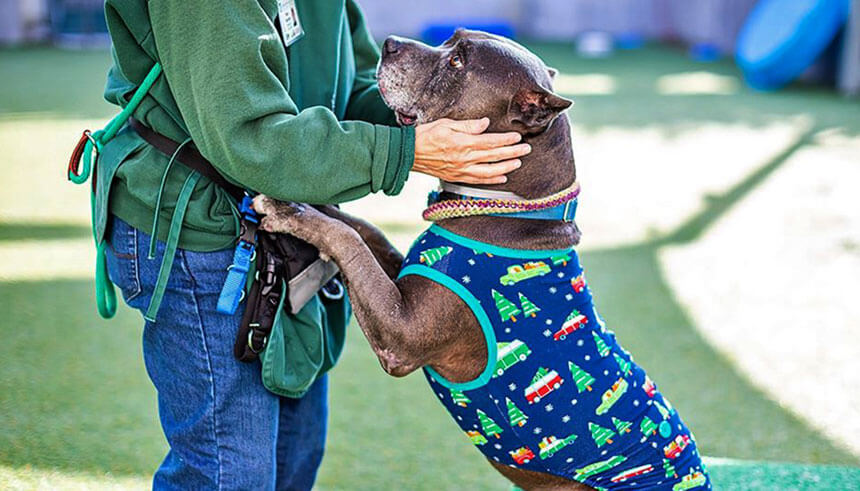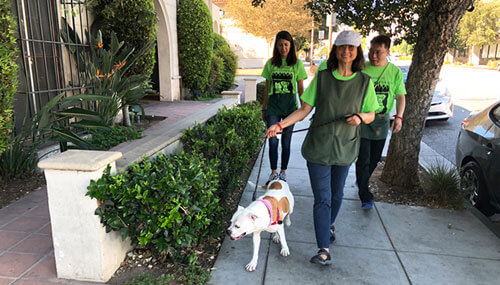East West Lifestyle
Meet Your New Best Friend: How Fostering Can Help Transform an Animal’s Life
By Melody Yuan

A little care can go a long way with Pasadena Humane Society & SPCA’s foster field trips program.
Meet Marky Mark (Pet ID A479839), a brown and tan chihuahua mix. A friendly 3-year-old who loves fun walks and heartfelt talks, Marky Mark is the perfect companion if you’re looking for a skilled listener and cuddle bug. He’s been at the Pasadena Humane Society since July of 2019, and the level of detail in the description of Marky Mark’s personality comes from the time and care that Humane Society and SPCA volunteers dedicate to making every animal more adoptable. Each description is uploaded to their website, along with a handsome picture of the animal, which makes it easier for potential adopters to identify and meet their new best friend.
“On any given day here at the Pasadena Humane Society, there’s probably a few hundred animals a week—and sometimes more—depending on the time of the year and what’s going on in the community,” says Jack Hagerman, vice president of outreach and communications at the Pasadena Humane Society & SPCA.

“On any given day here at the Pasadena Humane Society, there’s probably a few hundred animals a week—and sometimes more—depending on the time of the year and what’s going on in the community.”
Recently, the Pasadena Humane Society became part of Maddie’s Fund, which is a family foundation invested in community lifesaving, shelter management leadership, shelter medicine education and foster care across the U.S. Specifically, the Pasadena Humane Society is part of a foster care program study that looks at the effects that foster care has on shelter animals.
Kennels can be taxing environments for animals; they can hear and smell the other animals, but they aren’t able to see them, which can give them anxiety. “We’re very fortunate to have such great weather in Southern California, and we have beautiful kennels indoors and outdoors,” says Hagerman. “But even in a beautiful setting like ours, being in a shelter is a very stressful experience for the animals.”
“The fostering program lets us take dogs out for several hours or overnight, and helps the dog get out of a shelter and into a warm environment,” says Ken Kiyama, a volunteer at the Pasadena Humane Society. “It helps dogs remember what it’s like to be a real dog.”
Kiyama, a star volunteer who has been with the Pasadena Humane Society for the past four years, strongly believes that the program is a win-win for both the volunteer and the dog. “Due to life circumstances, I can’t have a dog of my own, but honestly, this is the next best thing to having a dog. I tell my friends that instead of having just one dog, I get to have 40,” he says.
Creating favorable first impressions
“Imagine you’re dressed up at an event, and you’re meeting someone for the very first time. That first impression of you is probably going to be pretty favorable. Now, imagine meeting someone for the first time in a hospital room where everyone is stressed out and it’s not pleasant being there. Your best foot forward is not going to be your very best foot because of all the stress that’s around you. That’s what it’s like to be an animal at a shelter,” says Hagerman.
Marky Mark is the perfect example of this scenario. “On campus, you can’t touch him, you can’t pet him, and you can’t leash him without getting snapped at,” says Hagerman. “We worried that he wouldn’t be adoptable since he was so difficult to work with in the shelter.” Then, one of the foster volunteers who had been working with Marky Mark for some time offered to take him home to see if a warmer environment would change his biting habits.
“While out this Thanksgiving, I was waiting for a call to our emergency line, but lo and behold, I got videos of Marky Mark playing ball in the yard, cuddling and asking for pets. I had never seen Marky Mark be so affectionate!” exclaims Hagerman.
Taking animals out of the stressful shelter environment is a crucial step in establishing trust with humans and making them more adoptable. “I like socializing with the shelter animals to help them bond with humans and increase their chances of being adopted,” says Ling Chen, assistant vice president and senior financial planner at East West Bank. “The process itself is therapeutic and rewarding. I signed up through the volunteer program that East West Bank hosted last summer, and I’ve started volunteering since. I’ve now accumulated over 50 hours.”
East West Bank first got involved in 2018, during the lunar calendar’s Year of the Dog. “We participated in the Pasadena Humane Society’s Wiggle Waggle Walk, and we’ve averaged about 40 volunteers,” says Carrie Gan, assistant vice president and community partnership manager at East West Bank. A big cat lover herself, Gan enjoys seeing her team and the volunteers’ enthusiasm and energy. “Most of all, it’s heartwarming to see how many people have huge hearts to help our furry friends in need,” she says.
“We participated in the Pasadena Humane Society’s Wiggle Waggle Walk, and we’ve averaged about 40 volunteers. Most of all, it’s heartwarming to see how many people have huge hearts to help our furry friends in need.”

“We don’t always know what their story was before they got here,” says Hagerman. “They may have been in a really loving home that got ripped away from them all of a sudden. Or maybe they were in a situation where they were being abused, and now they’re all alone. Either way, being at the shelter is an unsettling experience, so we’re trying to get them out of the kennels as often as possible to bring back some joy into their world. What we’ve found is that even just getting them out for two to three hours a day is really helpful in decreasing their stress levels.”
Watching wallflowers blossom
“Ham was an owner surrender dog,” says Kiyama about Hammy (Pet ID: A471288), the gentle dog he’s taking on a walk. “When Ham first came to us, he had some health and skin issues, and was very reluctant to be touched. He became one of our ‘wallflowers,’ which is a category that’s assigned to a dog by the behavior staff after evaluation.”
The wallflower category consists of dogs that are shy, fearful and hesitant to interact with people; most of them often retreat to the back of the kennel rather than greeting potential adopters. The objective of the staff and volunteers at the Pasadena Humane Society is to convert these wallflowers into sociable and adoptable pets.
“Over time, we’ve worked with Ham to teach him how to be comfortable around people,” says Kiyama. “And now anytime Ham sees a harness, he’ll step right up and sometimes even put his head in through the harness to help you. He’s gotten much more comfortable approaching people, and he’s eager to get a walk and happy to be touched.”
The foster program began in March of 2019, and the Pasadena Humane Society is constantly on the look out for more volunteers. “Right now, we’re averaging about 40 field trips a month, and we’d love to get that number up just because it’s better for the animals,” says Hagerman. “To date, we’ve done close to 200 foster field trips. At first, we started doing it because it was part of the Maddie’s Fund study, but we’ve seen just how valuable it is for the enrichment of our animals, so we’re going to be doing this long past the study period.”
There is a visible change between a dog that has been on a foster field trip program versus a dog that has been in a kennel all day. “You see a dog’s real personality once it’s outside the shelter,” says Kiyama. “You may see frustrated dogs barking in their kennel all the time, but once they’ve had a chance to go away and be normal, they tend to be calmer when they come back. Some of the kennel staff say that they sleep much better at night on the days they come back from a field trip. It’s a great chance for a dog to just be a dog.”
A little love goes a long way
To qualify as a volunteer, you simply sign up for the Pasadena Humane Society’s volunteer orientation program. “You need to take a few trainings and some shadow shifts with other more experienced volunteers, so we can see that you’re engaging with the animals safely and that you have all the knowledge you need to safely manage difficult situations outside of the shelter,” says Hagerman. “Once you’re good, you can go and check out an animal as much as you want. You can even check one out every day.”
While there are many animal lovers in the neighborhood, many have reservations about volunteering at an animal shelter. “Some of my friends and other people I know say that they’d love to volunteer, but the problem is that they’d fall in love with the dogs and want to take them all home,” says Kiyama. “I tell them to look at it like they’re making new friends. It’s a bit sad when a dog gets adopted and goes home to a new family, but I see it as my good friend moving on to something better, and I’m happy for them.”

“You may see frustrated dogs barking in their kennel all the time, but once they’ve had a chance to go away and be normal, they tend to be calmer when they come back.”
Another constraint that most people state is the need to commit to a volunteer program. “I think one of the things that’s difficult for people who are interested in volunteering is the accountability of doing so consistently,” says Hagerman. “A lot of people think you need to commit to doing this once a week or once a month, but with foster care, once you get through the training, you can really do it whenever it moves you.” What Hagerman means is that the foster program is flexible and rewarding. Have a free afternoon on a beautiful day? Why not go out on a hike and take a shelter dog with you?
“I think there are a lot of places in Los Angeles that don’t allow people to own pets,” says Hagerman. “So for animal lovers who can’t provide a home for shelter animals, this is a great way to get that ‘fix’ of enjoying the activities that you’d do with an animal without the financial accountability or ownership.”
For animals like Marky Mark and Hammy, the time spent with volunteers during their foster field trips is invaluable. While both dogs are not adopted yet, the foster program and care from the volunteers have already made them more adoptable.
“I love spending time with these dogs,” says Kiyama. “You see different dogs, and sometimes they’re a lot of fun to spend time with. But sometimes you see something in their past where they haven’t been socialized or treated properly, and they just need some tender love and care. That’s where the volunteers come in and are able to give that to them. It’s a joy to see the dog blossom and become a friendlier dog that people are going to want to adopt and take home as a member of the family.”
Subscribe to the Reach Further Newsletter
Get inspiring stories in your inbox every month.

